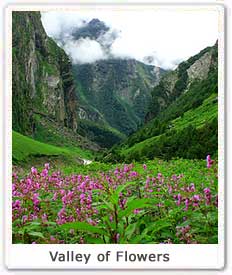Time to Visit : From mid July to mid of August. The valley can be visited only during the day and overnight stay is prohibited.
Weather : Salubrious and Pleasant.
Known For : The Rich Biological Resource.
The Valley Of Flowers

Discovered by Frank S. Smith, an English mountaineer explorer and Botanist, while on an expedition to Mt. Kamet, the Valley of Flowers is a Nature's Gift to Man. The Valley of Flowers in the north Indian state of Uttranchal is a booming bouquet of beautiful, lively and multihued flowers. The Valley of Flowers National Park, spanning over an area of 87.5 sq km has the largest potpourri of wild flower species. Known to the inhabitants as the Bhyundar valley, the Valley of Flowers is hidden from the scrutinizing eyes of the civilization. The valley was declared a National Park in year 1982.
The Valley of Flowers is also associate with the legendary story, which says that this the area from where Hanumanji of Ramayana collected 'Sanjeevani' herb to revive Lakshman. The Valley of Flowers National Park starts from Ghangharia but the main valley starts after crossing the gorge and the stream originating from Nar Parvat, 3 km from Ghangharia. In front of the Valley stands the snow capped peak of Ratban Parvat and at the background is the Kunt Khal. Towards the left is Nar Parvat, which bisects the Badrinath valley from this valley, and to the right is thick Birch forest on the hill sides. Below the forest is the meadow. River Pushpavati flows through the valley and there are many waterfalls enhancing the beauty of the valley. The splendour and the dazzling beauty of the valley beckons tourists from all the corners of the world.
Eco-Tourism in Valley of Flowers - Uttaranchal
Valley of Flowers' Wildlife Resource
Almost 300 species of wild flowers bloom here in natural way. The bloom starts immediately after the melting of snow but the peak blooming period is from mid July to mid of August. The abundant natural resource of the valley captivates a large number of nature lovers, environmentalists and tourists every year.

The wild flowers like the Himalayan blue poppy, daisy, dianthus, calendula, white and yellow anemones bloom & swing with life during the monsoons. Some other species are Anemone, Geranium, Marsh marigold, Prinula, Potentilla, Geum, Asters, Lilium, Ranunculus, Corydalis, Inula, Braham kamal, Campanula, Pedicularis, Arisaema, Morina, Impatiens, Bistorta, Ligularia, Anaphalis, Saxifrages, Sibbaldia, Thermopsis, Trollius, Codonopsis, Dactylorhiza, Cypripedium, Strawberry, Epilobium, Rhododendrons and numerous others. Most of the flowers have medicinal values too. The abundance of Asmanda fern in this valley is a rare sight than in other Himalayan valleys. The valley remains in bloom for three months while the floral arrangement keeps on changing every few days. By September the hue of the Valley starts changing and autumn bids farewell to flowers and the entire vegetation remains resting continuously for next five months when the valley is snow wrapped.
Apart from the flowers some species of Butterfly, Musk deer, Blue sheep (Bharal), Himalayan bear, Himalayan mouse hare and some Himalayan birds & Snow leopard are also found in this area. To conserve the nature's beneficient gift and to maintain the natural balance of the valley.
Reaching the Valley of Flowers
Air : The nearest airport is Jolly Grant, Dehradun, 319 km.
Rail : The nearest railhead is at Rishikesh, 302 km.
Road : Off the Rishikesh-Badrinath road, 17 km from Govindghat. (25 km from Badrinath). From Govindghat the distance has to be trekked. Bus services are available to Govindghat. Porters are available at Govindghat and Ghangharia.






